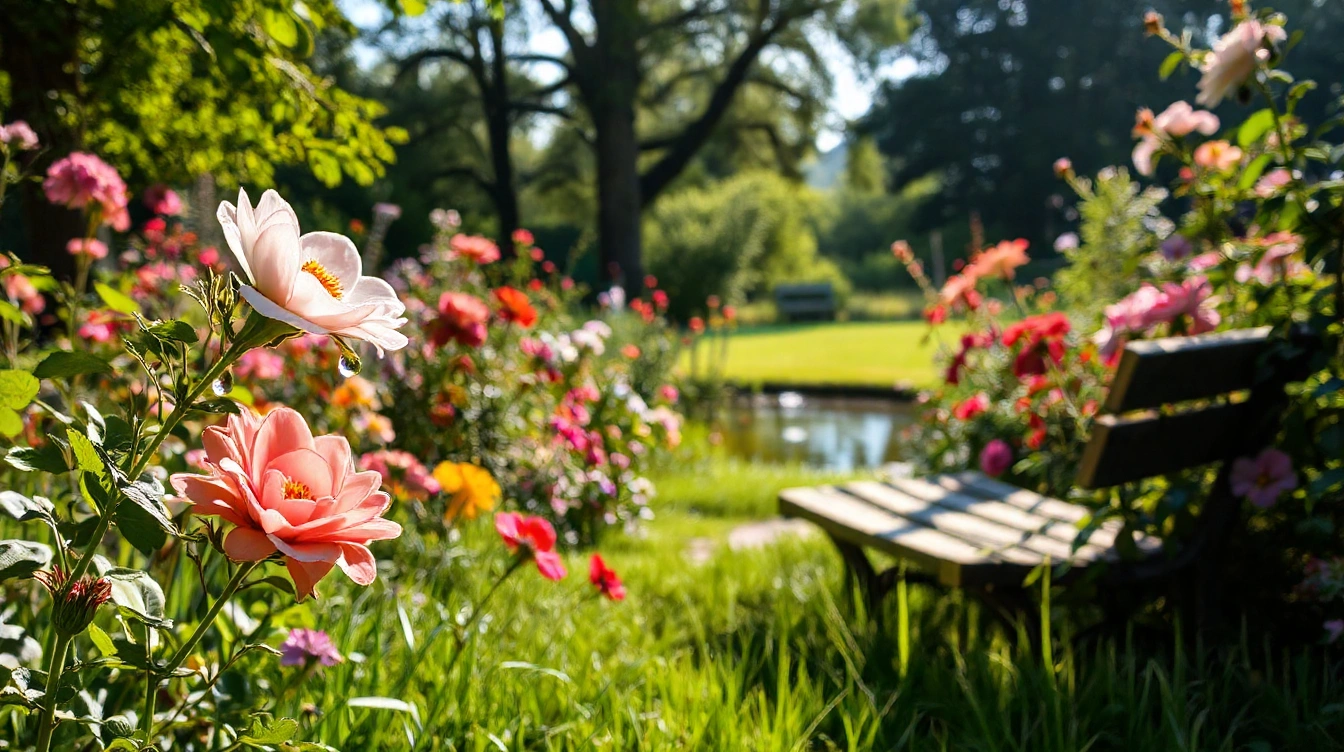Adapting UK Home Gardens to Climate Change: Key Strategies
Preparing your garden for climate change means adopting practical and effective UK garden adaptation techniques. Increasingly unpredictable weather patterns demand immediate attention to build garden resilience against extremes like droughts, heavy rain, and temperature fluctuations.
Start by selecting plants suited to the evolving climate—opt for drought-tolerant and native species that thrive despite erratic conditions. This step alone significantly improves garden survival rates and reduces maintenance needs. Next, water management is critical; installing rainwater harvesting systems or using mulch to retain soil moisture can conserve water during dry spells. Addressing soil health ensures your garden remains fertile despite harsh weather. Regularly enriching soil with organic matter improves water retention and nutrient availability, creating a buffer against stress.
Have you seen this : How can you design a sensory garden for relaxation in the UK?
Pest management also must evolve with changing climates. Warmer seasons can increase pest activity and introduce new threats. Integrated pest control practices, such as encouraging beneficial insects and using natural remedies, help maintain balance without harming the environment.
By focusing on these key areas—plant selection, water conservation, soil care, and pest control—UK gardeners can proactively adapt and thrive amid climate change challenges. These garden resilience tips are practical tools for safeguarding your outdoor space.
Also read : How Can You Transform Your UK Garden into a Haven for Pollinators?
Selecting Climate-Resilient Plants for UK Gardens
Choosing drought-tolerant plants UK is crucial for gardeners facing increasingly unpredictable weather. Prioritising native plants for UK gardens helps promote ecological balance while ensuring the species are adapted to local conditions. Native varieties often withstand climate fluctuations better, reducing maintenance and water needs.
Incorporating a mix of climate-resilient species creates a buffer against extreme events like heatwaves and dry spells. This diversity limits the risk that a single weather pattern will devastate an entire garden. Combining deep-rooted drought-tolerant plants with those tolerant to cooler, wetter periods supports a balanced ecosystem over time.
Expert guidance and ongoing research are invaluable when selecting these plants. Consulting horticultural studies and specialist advice helps identify which drought-tolerant plants UK and native species will thrive. This strategy not only enhances resilience but also creates an attractive, sustainable garden that adapts naturally.
By integrating a thoughtful selection of native, diverse, and drought-tolerant species, gardeners can confidently prepare for climate stresses, maintaining beauty and biodiversity in their outdoor spaces.
Water Management Strategies for Variable Weather
Managing water sustainably is crucial for gardens facing the UK’s unpredictable weather. Rainwater harvesting offers an effective way to capture and store runoff during heavy rains. By collecting rainwater in barrels or tanks, gardeners can secure a reliable water source for drier periods, promoting sustainable water use throughout the growing season.
To minimize moisture loss, techniques like soil mulching and using groundcover plants are highly beneficial. Mulching not only reduces evaporation but also regulates soil temperature and suppresses weeds, all essential for conserving water in varying climates. Groundcovers act as a protective layer, shielding soil from sun exposure and wind, which can otherwise accelerate drying.
Implementing efficient irrigation systems designed for UK gardens can further optimize water use. Drip irrigation or soaker hoses deliver water directly to plant roots, reducing waste and ensuring precise watering. Timing irrigation to early mornings or late evenings also maximizes absorption and cuts down on evaporation.
By combining rainwater harvesting, mulching, and smart irrigation, gardeners can effectively adapt to weather fluctuations while supporting sustainable water use in their outdoor spaces.
Sustainable Soil Care for Climate Resilience
Developing soil health in the UK is crucial to adapting gardening practices amid changing climate patterns. One of the most effective strategies is building soil organically through composting, which enriches soil with essential nutrients and beneficial microorganisms. This process not only boosts fertility but also improves the soil’s capacity to retain moisture during dry spells.
Implementing regenerative gardening techniques, particularly no-dig methods, supports soil structure and biodiversity. By minimizing disturbance, no-dig gardening helps preserve earthworms and microbial communities vital for nutrient cycling. This approach enhances resilience by maintaining soil’s natural layering and aeration, preventing compaction that could worsen flooding risks.
In areas prone to unpredictable rainfall, amending soil to balance drainage and retention becomes essential. For example, adding organic matter improves water retention in sandy soils, while incorporating coarse materials into heavy clay promotes drainage. These tailored amendments help soil manage moisture fluctuations more effectively, reducing stress on plants and sustaining growth through variable weather.
Together, these methods form an integrated approach to sustainable soil care, helping gardeners across the UK build resilient ecosystems that adapt naturally to climate variability.
Eco-Friendly Gardening Practices
Adopting eco-friendly gardening UK methods means reducing reliance on chemical inputs such as synthetic fertilizers and pesticides. This shift not only protects the soil and water quality but also promotes a healthier garden ecosystem. Instead, organic gardening techniques focus on natural soil enrichment through composting and using organic matter, which improves soil fertility and plant health without harmful residues.
Another key aspect of eco-friendly gardening UK is encouraging beneficial insects and pollinators. Creating a welcoming environment for bees, ladybugs, and butterflies can naturally control pests and enhance pollination. Planting native flowers and avoiding broad-spectrum pesticides helps maintain these essential populations.
Wildlife gardening plays an integral role in supporting biodiversity. By incorporating bird feeders, insect hotels, and native plants, gardeners provide habitats for various species, increasing garden resilience. This approach complements organic gardening principles, fostering a balanced ecosystem where plants and animals thrive together naturally.
Together, these eco-friendly techniques contribute to sustainable gardening that benefits both nature and gardeners, proving that a thoughtful approach can yield beautiful, productive spaces while protecting the environment.
Building Pest and Disease Resilience
Developing garden pest resilience is crucial in the face of climate change, which influences the distribution and behavior of many pests. Effective UK pest management begins with vigilant monitoring, allowing gardeners to detect early signs of emerging pests before infestations escalate. Implementing early intervention strategies can prevent significant damage and reduce reliance on chemical treatments.
One practical technique is companion planting, where certain plants act as natural deterrents by repelling harmful insects or attracting beneficial predators. For example, planting marigolds alongside vegetables can ward off aphids and nematodes. This method aligns with the principles of integrated pest management (IPM) that promote ecological balance.
Adapting to shifting pest and disease patterns requires staying informed through expert guidance. Gardening experts can provide tailored advice on recognizing new threats brought by climate variability and recommend preventive measures. Combining scientific insights with traditional techniques helps maintain a healthy garden ecosystem despite environmental changes, making Integrated pest management an essential approach for sustainable gardening in the current climate.
Increasing Resilience to Extreme Climate Events
Gardens face growing challenges from extreme weather gardening, requiring proactive steps to protect plants against storms, frost, and intense heat. One effective approach is installing physical barriers like cloches for frost protection, shade netting to reduce heat stress, and windbreaks that shield delicate plants from damaging gusts. These tools create microenvironments that mitigate the harsher elements of extreme weather.
Selecting the right planting locations plays a crucial role in boosting resilience. Positioning plants near walls or hedges can take advantage of natural microclimates, offering warmth during cold snaps and shelter from dry winds. Areas with good drainage reduce flooding risks during heavy rainfall.
Preparation for heatwaves, frost, and heavy rain is vital. For heat, supplying mulch keeps soil moisture steady and cools roots. To prevent frost damage, cover tender crops overnight with breathable fabric or cloches. In anticipation of heavy rains, improving soil structure through organic matter helps absorb excess water, reducing erosion and root rot.
By combining these strategies—physical barriers, strategic planting, and weather-specific preparations—gardeners can significantly enhance their garden’s ability to withstand extreme climate events and maintain plant health year-round.
Staying Informed: Research, Tools, and Community
Keeping up with gardening advice UK is essential in adapting to ever-changing climate conditions. Leveraging recent UK-focused climate research helps gardeners understand shifts in weather patterns—such as rainfall variability and temperature changes—that directly impact planting schedules and crop choices. These studies provide evidence-based insights, enabling gardeners to make informed decisions that boost plant resilience.
Modern gardening apps and weather monitoring tools offer practical, real-time support. By using such technology, gardeners receive precise climate data tailored to their location, improving the timing for sowing seeds or protecting plants against frost. Many apps incorporate expert tips gardening professionals trust, giving users confidence in their daily care routines.
Joining local gardening networks is invaluable. Community members share firsthand experiences, adapting general advice to specific microclimates. These connections provide a supportive platform for exchanging practical solutions, like pest management and soil improvement. Gardeners benefit from a sense of belonging while staying updated on climate resources for gardeners, leveraging collective knowledge to overcome challenges effectively.









